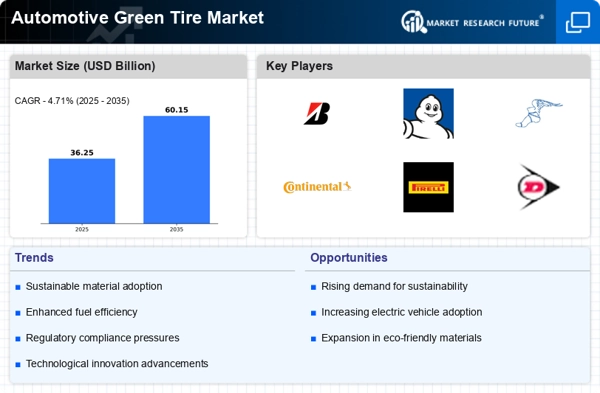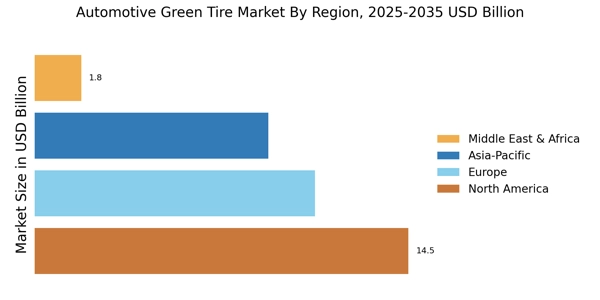Regulatory Support for Sustainability
The Automotive Green Tire Market is experiencing a surge in demand due to increasing regulatory support for sustainable practices. Governments are implementing stringent regulations aimed at reducing carbon emissions and promoting eco-friendly products. This regulatory environment encourages manufacturers to invest in green tire technologies, which utilize sustainable materials and processes. For instance, the European Union has set ambitious targets for reducing greenhouse gas emissions, which has led to a projected increase in the adoption of green tires by 25% over the next five years. As regulations tighten, the Automotive Green Tire Market is likely to see a shift towards more environmentally responsible manufacturing practices, thereby enhancing market growth.
Rising Fuel Prices and Economic Factors
Economic factors, particularly rising fuel prices, are influencing the Automotive Green Tire Market. As fuel costs continue to escalate, consumers are increasingly looking for ways to improve fuel efficiency, which green tires can provide. Tires designed with lower rolling resistance can enhance vehicle fuel economy, making them an attractive option for cost-conscious consumers. This trend is expected to drive a 15% increase in green tire sales over the next few years. Additionally, as the automotive industry shifts towards more sustainable practices, the Automotive Green Tire Market is likely to benefit from the growing emphasis on cost-effective, eco-friendly solutions.
Consumer Demand for Eco-Friendly Products
There is a notable shift in consumer preferences towards eco-friendly products, which significantly impacts the Automotive Green Tire Market. As awareness of environmental issues grows, consumers are increasingly seeking products that align with their values. This trend is reflected in the tire market, where sales of green tires have risen by approximately 30% in recent years. Consumers are willing to pay a premium for tires that are made from sustainable materials and offer lower rolling resistance, which contributes to fuel efficiency. This growing demand for eco-friendly options is likely to drive innovation and competition within the Automotive Green Tire Market, pushing manufacturers to enhance their product offerings.
Technological Advancements in Tire Manufacturing
Technological advancements are playing a crucial role in shaping the Automotive Green Tire Market. Innovations in materials science and manufacturing processes are enabling the production of tires that are not only more sustainable but also high-performing. For example, the development of bio-based rubber and advanced recycling techniques has led to the creation of tires that reduce environmental impact without compromising on quality. The market is projected to grow by 20% over the next five years, driven by these technological improvements. As manufacturers adopt new technologies, the Automotive Green Tire Market is likely to witness enhanced product performance and increased consumer acceptance.
Collaboration Between Automakers and Tire Manufacturers
Collaboration between automakers and tire manufacturers is emerging as a key driver in the Automotive Green Tire Market. Partnerships are being formed to develop tires that meet the specific needs of electric and hybrid vehicles, which often require specialized tire designs for optimal performance. These collaborations are fostering innovation and leading to the creation of tires that not only reduce environmental impact but also enhance vehicle efficiency. As automakers increasingly prioritize sustainability in their supply chains, the Automotive Green Tire Market is expected to see a rise in joint ventures and research initiatives, further propelling market growth.


















Leave a Comment